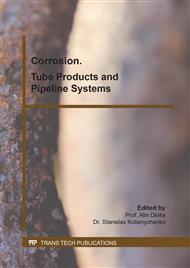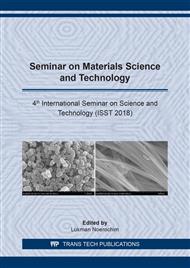p.1
p.7
p.13
p.19
p.26
p.33
p.40
p.45
Effect of pH, Rotation Speed and Imidazoline - Paracetamol Based Inhibitor Volume Ratio on Corrosion Protection of St 41 Steel in CO2 Environment Using Rotating Cylinder Electrode (RCE)
Abstract:
Inhibitor is a chemical compound which commonly used to control corrosion in a tank or a pipelines. Organic inhibitor recently developed because of the availability and the ability to act like commercial inhibitor. The performance of mixed inhibitor was studied on St 41 carbon steel immersed in NaCl solution containing CO2 gas. Research parameter used were pH 4 and 6, rotation speed of 150 and 250 rpm, with mixed inhibitor volume ratio of 1 (imidazoline) : 2 (paracetamol), 1:1, also 2:1. The Weight loss measurement, isotherm adsorption calculation, FTIR, and XRD measurement have also been done. Based on weight loss test, the highest inhibitor efficiency was 61.412 % at pH 6, 150 rpm, with inhibitor volume ratio of 2:1, adsorption isotherm calculation indicate the adsorption mechanism of the mixed inhibitor is physical adsorption. Tafel test result showed the tendency of inhibitor worked anodically. The FTIR spectrum result found functional group of N-H from the inhibitor precipitated on the metal surface after ten days of immersion Based on the EIS result, there was an increase value of polarization resistance value and decrease on CPE (constant phase element) value. While X – ray diffraction (XRD) result from the volume ratio of 1:2 confirm the CO2 corrosion product FeCO3 and Fe2O3 formed on metal surface. With volume ratio of 2:1 mixed inhibitor, it was confirmed that iron nitride (Fe24N10) compound was formed on steel surface because of the chemisorption reaction between Fe and nitrogen atom from pyridine at the imidazoline inhibitor. The inhibition mechanism was physisorption for entire parameters, based on calculation of Langmuir adsorption theorem.
Info:
Periodical:
Pages:
7-12
Citation:
Online since:
July 2019
Authors:
Keywords:
Price:
Сopyright:
© 2019 Trans Tech Publications Ltd. All Rights Reserved
Share:
Citation:



